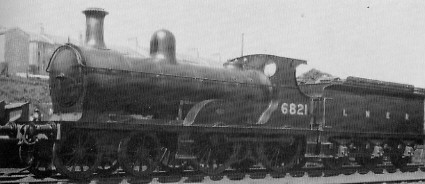The D41 (GNSR Johnson Class S & Pickersgill Class T) 4-4-0 Locomotives

The D41 class was the most numerous Great North of Scotland Railway (GNSR) locomotive class to enter LNER ownership. The GNSR classified these engines as two separate classes. J. Johnson designed the Class S locomotives, and six were built in 1893 by Neilson & Co. Pickersgill made some detail modifications to produce the Class T locomotives. Twenty six Class T engines were built in two batches between 1895 and 1898. The first batch of fourteen was also built by Neilson. Sharp Stewart tendered a lower price for the final batch, but Neilson were able to offer quicker delivery, and won the contract. The differences between the two classes were only minor and they tended to disappear over time, so there was logic in the LNER's decision to group them all together in the same class.
A number of the D41s received new boilers before Grouping (1923). Many of the replacement boilers were built at Inverurie, but some were also purchased from outside contractors. The LNER tended to freely swap boilers between the D41s, D40s, and G10 0-4-4Ts. Little change was made to the new boilers, although five received longer smokeboxes in about 1930 in a failed attempt to improve coal economy and reduce smokebox burning.
The Class S engines were built with open-topped domes with a single lock-up safety valve. A second safety valve was fitted in a tall brass trumpet on the firebox. By Grouping, these valves had been replaced by Ramsbottom valves with seat and column casings placed on the firebox. The open topped dome was retained. In contrast, the Class T engines were built with closed domes and Ramsbottom safety valves on the firebox. The LNER replaced both variants of Ramsbottom valve with Ross pop safety valves. All new boilers built after 1925 were fitted with Ross pop valves. The LNER initially used flat topped dome covers on the D41s, but eventually fitted traditional shaped domes.
The original Furness lubricators were replaced with Detroit sight-feed lubricators before Grouping (1923).
The D41s initially hauled the most important main line passenger duties, and they were allocated to Kittybrewster, Keith, and Elgin. Later D40s displaced them from some of these duties.
The GNSR was notable for its low levels of freight and mineral traffic. Hence it never built any freight 0-6-0 locomotives, and was forced to use its various 4-4-0s for seasonal freight workings, unbalanced goods and passenger duties, and even shunting. The D41s were no exception, and by Grouping (1923) they could found on all of these duties as well as their original main line duties. In 1935 they were allocated to: Kittybrewster (16), Keith (12), and Elgin (4).
During World War 2, the GNS section was seeing reduced passenger levels with no increase in goods traffic. In contrast, the North British section was seeing a huge increase in goods traffic and was having problems finding sufficient locomotives. This led to Nos. 6882-3 being transferred to Fife in March 1940, and Nos. 6880 & 6898 being transferred to St. Margaret's in March 1943. These latter engines were considered too weak for most of St. Margaret's traffic, so they were usually restricted to short distance pick-up goods workings. All four returned back to the GNS section by December 1943.
Withdrawals started in 1946 but twenty two survived to Nationalisation (1948). The introduction of large numbers of Thompson B1s meant that the D41s were redundant by this point, and withdrawals continued at a steady rate. The last D41 was withdrawn in 1953. Final duties included mixed duties on the Speyside line, Lossiemouth branch workings, and station pilot at Elgin.
Technical Details
| Cylinders (x2): | (inside) | 18x26in. |
| Motion: | Stephenson | |
| Valves: | slide | |
| Boiler: | Max. Diameter: | 4ft 6in |
| Boiler: | Pressure: | 165psi |
| Diagram No.: | 88 | |
| Heating Surface: | Total: | 1172.5 sq.ft. |
| Firebox: | 113.5 sq.ft. | |
| Tubes: | 1059 sq.ft. (213x 1.75in) | |
| Grate Area: | 18.24 sq.ft. | |
| Wheels: | Leading: | 3ft 9.5in |
| Coupled: | 6ft 1in | |
| Tender: | 4ft 1in | |
| Tractive Effort: | (@ 85% boiler pressure) | 16,184 lb |
| Wheelbase: | Total: | 43ft 4.5in |
| Engine: | 21ft 9.5in | |
| Tender: | 13ft 0in | |
| Weight (full): | Total: | 82 tons 8cwt |
| Engine: | 45 tons 0cwt | |
| Tender: | 37 tons 8cwt | |
| Adhesive Weight: | 30 tons 15cwt | |
| Max. Axle Load: | 15 tons 17cwt |
Preservation
The last D41 was withdrawn in 1953, and none have survived into preservation.
Models
Nu-Cast sell a 4mm scale (OO gauge) kit of the D41.
S.M.Models have produced a kit for O gauge (7mm scale). Current availability is unknown.